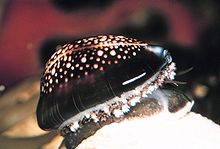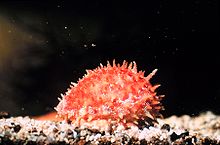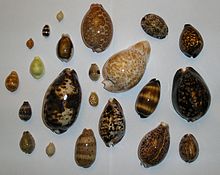
Back ودع Arabic কড়ি Bengali/Bangla Cauris Catalan Kauri Czech Laɣakpahara DAG Cauri Spanish سپیدمهره Persian Cauri French Fínicín Irish कपर्दक Hindi
| Cowrie Cowry | |
|---|---|

| |
| Cowries are generally seen on rocky areas of the sea bed. | |
| Scientific classification | |
| Domain: | Eukaryota |
| Kingdom: | Animalia |
| Phylum: | Mollusca |
| Class: | Gastropoda |
| Subclass: | Caenogastropoda |
| Order: | Littorinimorpha |
| Superfamily: | Cypraeoidea |
| Family: | Cypraeidae |


Cowrie or cowry (pl. cowries) is the common name for a group of small to large sea snails in the family Cypraeidae.
The term porcelain derives from the old Italian term for the cowrie shell (porcellana) due to their similar appearance.[1]
Cowrie shells have held cultural, economic, and ornamental significance in various cultures. The cowrie was the shell most widely used worldwide as shell money. It is most abundant in the Indian Ocean, and was collected in the Maldive Islands, in Sri Lanka, along the Indian Malabar coast, in Borneo and on other East Indian islands, in Maluku in the Pacific, and in various parts of the African coast from Ras Hafun to Mozambique. Cowrie shell money was important in the trade networks of Africa, South Asia, and East Asia.
In the United States and Mexico, cowrie species inhabit the waters off Central California to Baja California (the chestnut cowrie is the only cowrie species native to the eastern Pacific Ocean off the coast of the United States; further south, off the coast of Mexico, Central America and Peru, Little Deer Cowrie habitat can be found; and further into the Pacific from Central America, the Pacific habitat range of Money Cowrie can be reached[2]) as well as the waters south of the Southeastern United States.[3]
Some species in the family Ovulidae are also often referred to as cowries. In the British Isles the local Trivia species (family Triviidae, species Trivia monacha and Trivia arctica) are sometimes called cowries. The Ovulidae and the Triviidae are other families within Cypraeoidea, the superfamily of cowries and their close relatives.
- ^ "Home : Oxford English Dictionary". Oed.com. Archived from the original on 10 August 2022. Retrieved 10 August 2022.
- ^ "A Cowry Shell Artifact from Bolsa Chica : An Example of Prehistoric Exchange" (PDF). Pcas.org. Retrieved 10 August 2022.
- ^ "Cowrie". Infoplease.com.